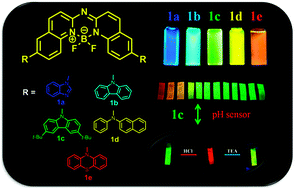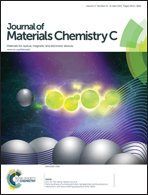Aza-boron-diquinomethene complexes bearing N-aryl chromophores: synthesis, crystal structures, tunable photophysics, the protonation effect and their application as pH sensors†
Abstract
A series of aza-boron-diquinomethene complexes (1a–1e) bearing different N-aryl chromophores were synthesized and characterized by multinuclear NMR spectroscopy, X-ray crystallography, optical absorption and emission spectroscopy, and elemental analysis. These robust thermal complexes possess tunable intense luminescence from blue to red with relatively high emission quantum yields. The introduction of different N-aryl chromophores into the aza-BODIQU core significantly tuned the emission colors. The relationship between their structures and properties was investigated systematically via spectroscopic methods and simulated by density functional theory (DFT) calculations. Additionally, the application of 1c as a pH sensor with a remarkable colour-changing property has been investigated. All these results indicate that these complexes exhibit robust thermal stability, tunable photophysical properties, relatively high photoluminescence quantum yields and protonation effect, making these complexes potential candidates for pH sensors, bioimaging probes and organic light-emitting materials.


 Please wait while we load your content...
Please wait while we load your content...